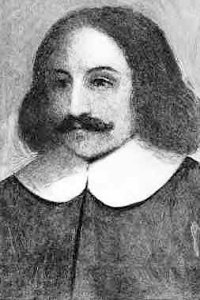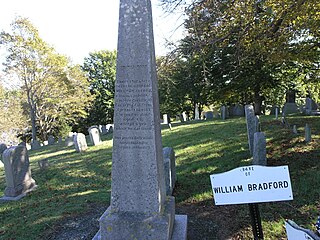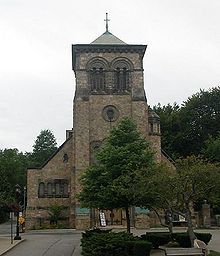
Plymouth Colony was the first permanent English colony in New England from 1620 and the third permanent English colony in America, after Newfoundland and the Jamestown Colony. It was settled by the passengers on the Mayflower at a location that had previously been surveyed and named by Captain John Smith. The settlement served as the capital of the colony and developed as the town of Plymouth, Massachusetts. At its height, Plymouth Colony occupied most of the southeastern portion of Massachusetts. Many of the people and events surrounding Plymouth Colony have become part of American folklore, including the American tradition of Thanksgiving and the monument of Plymouth Rock.

William Bradford was an English Puritan Separatist originally from the West Riding of Yorkshire in Northern England. He moved to Leiden in Holland in order to escape persecution from King James I of England, and then emigrated to the Plymouth Colony on the Mayflower in 1620. He was a signatory to the Mayflower Compact and went on to serve as Governor of the Plymouth Colony intermittently for about 30 years between 1621 and 1657. He served as a commissioner of the United Colonies of New England on multiple occasions and served twice as president. His journal Of Plymouth Plantation covered the years from 1620 to 1646 in Plymouth.

Plimoth Patuxet is a complex of living history museums in Plymouth, Massachusetts founded in 1947, formerly Plimoth Plantation. It replicates the original settlement of the Plymouth Colony established in the 17th century by the English colonists who became known as the Pilgrims. They were among the first people who emigrated to America to seek religious separation from the Church of England. It is a not-for-profit museum supported by administrations, contributions, grants, and volunteers. The recreations are based upon a wide variety of first-hand and second-hand records, accounts, articles, and period paintings and artifacts, and the museum conducts ongoing research and scholarship, including historical archaeological excavation and curation locally and abroad.

Degory Priest was a member of the Leiden contingent on the historic 1620 voyage of the ship Mayflower. He was a hat maker from London who married Sarah, sister of Pilgrim Isaac Allerton in Leiden. He was a signatory to the Mayflower Compact in November 1620 and died less than two months later.

First Parish in Cambridge is a Unitarian Universalist church, located in Harvard Square in Cambridge, Massachusetts. It is a Welcoming Congregation and a member of the Unitarian Universalist Association. The church is notable for its almost 400-year history, which includes pivotal roles in the development of the early Massachusetts government, the creation of Harvard College, and the refinement of current liberal religious thought.

First Parish Dorchester is a Unitarian Universalist church in Dorchester, Massachusetts. The congregation was founded by English Puritans who initially saw themselves as reformers rather than separatists, but increasingly intolerable conditions in England and at the urging of Reverend John White of Dorchester, Dorset, they emigrated to New England. On March 20, 1630 as they set sail from Plymouth, England on the Mary and John, the congregation wrote its founding church covenant. Nearly all of the 140 ship passengers originated in the West Country counties of Somerset, Dorset and Devon. In late May, the ship landed first at what became called Hull, Massachusetts, and then in June at a place called "Mattapan" by the indigenous people including the Massachusett and Wampanoag. The Puritans named their new home "Dorchester Plantation."

Cole's Hill is a National Historic Landmark containing the first cemetery used by the Mayflower Pilgrims in Plymouth, Massachusetts in 1620. The hill is located on Carver Street near the foot of Leyden Street and across the street from Plymouth Rock. Owned since 1820 by the preservationist Pilgrim Society, it is now a public park.

The First Parish Church is a historic Unitarian Universalist church at Tremont and Depot Streets in Duxbury, Massachusetts. First Parish Church is currently a member congregation of the Unitarian Universalist Association.

The Unitarian Universalist Meeting House of Provincetown is an historic church at 236 Commercial Street in Provincetown, Massachusetts. The Greek Revival building was built in 1847 based on a design by Benjamin Hallett, for a congregation that had been established in 1829. It is a massive post and beam timber-frame construction, and was originally built without the tower. The tower, which is telescopic in form, with Greek ornamentation, is the only surviving steeple in Provincetown, and is a landmark for seafarers.

The Unitarian Universalist Church of Medford and The Osgood House are a historic Unitarian Universalist church building and parsonage house at 141 and 147 High Street in Medford, Massachusetts.

The First Parish Unitarian Church, now the First Parish Unitarian Universalist Church of Medfield, is a historic church on North Street in Medfield, Massachusetts. The white clapboarded church was built in 1789, as the third for a congregation established c. 1652. In 1839 it was rotated on its site ninety degrees. It lost its steeple in the New England Hurricane of 1938. The steeple was replaced in 1988, and the building's many layers of paint were stripped off in 2007.

The First Parish Church is a historic church at 50 Church Street in Waltham, Massachusetts, whose Unitarian Universalist congregation has a history dating to c. 1696. The current meeting house was built in 1933 after a fire destroyed the previous building on the same site. It is a Classical Revival structure designed by the nationally known Boston firm of Allen & Collens. The church building was listed on the National Register of Historic Places in 1989.

Burial Hill is a historic cemetery or burying ground on School Street in Plymouth, Massachusetts. Established in the 17th century, it is the burial site of several Pilgrims, the founding settlers of Plymouth Colony. It was listed on the National Register of Historic Places in 2013.

Leyden Street is a street in Plymouth, Massachusetts that was created in 1620 by the Pilgrims, and claims to be the oldest continuously inhabited street in the Thirteen Colonies of British America. It was originally named First Street; afterward in the Records it was called Great and Broad Street. It was named Leyden Street in 1823, but it is also known as Leiden Street or The Street.

First Church in Salem is a Unitarian Universalist church in Salem, Massachusetts that was designed by Solomon Willard and built in 1836. Before the church was built, around 1635, its members had to gather in houses or a building near the Town House Square. The congregation claims to be "one of the oldest continuing Protestant churches in North America and the first to be governed by congregational polity, a central feature of Unitarian Universalism".

The First Church in Roxbury, also known as the First Church of Roxbury is the current headquarters of the Unitarian Universalist ("UU") Urban Ministry. A church on this site has been in use since 1632 when early English settlers built the first meetinghouse. Since then, the meetinghouse has been rebuilt four times, and its appearance today reflects how the meetinghouse looked in the late 19th and early 20th centuries.
First Parish in Malden, Universalist is a Unitarian Universalist ("UU") church in Malden, Massachusetts and a member congregation of the Unitarian Universalist Association. It was gathered in 1648 to support the establishment of the city of Malden. It is one of the oldest churches in Massachusetts. The current minister is the Rev. Otto O'Connor, who was called to be the congregation's minister in 2017.

First Parish of Sudbury refers to both an historic meetinghouse and a Unitarian Universalist congregation in Sudbury, Massachusetts, United States. The meetinghouse was built in 1797 on the site of the first meetinghouse built on the west side on the Sudbury River. The meetinghouse was designed by Captain Thomson and built at a cost of $6,025.93. It was paid for by the Town of Sudbury to be the meetinghouse for both Town Meetings and parish worship.



























